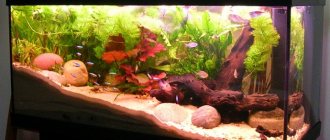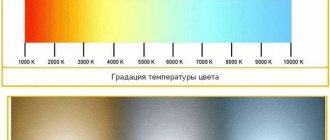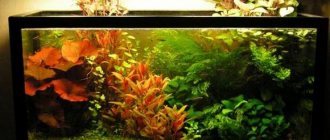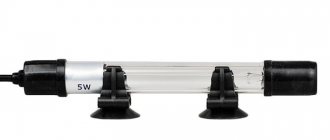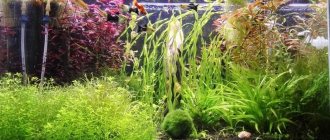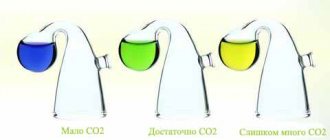For beginners buying an aquarium for the first time, everything seems simple. I bought what the pet store salesman recommended and there are no problems. In fact, after such thoughtless purchases, many questions and additional expenses arise. To avoid buying unnecessary attributes, we suggest you find out in advance: how to choose lamps for an aquarium, the appropriate lighting mode, intensity, frequency, etc.
General characteristics of aquarium lighting
Proper lighting of the aquarium biosphere is the key to the healthy life of the entire system. The light is absorbed by algae, which feed the microflora. It, in turn, maintains the necessary physical and chemical composition of water, which affects the health of fish and other fauna.
Nowadays, the standard reference point when determining the technical performance of aquarium light sources is power. It is indicated on the lamp packaging in Watts.
Generally recommended power characteristics of lamps per liter of water:
- 0.2 W – for systems with artificial flora.
- 0.2 – 0.4 W – for aquariums with minimal natural vegetation, when keeping nocturnal fish (night pearls, catfish). From plants: anubias, ferns, crinums.
- 0.3 – 0.5 W – for systems with an average content of algae (hygrophiles, hornworts, cabomba). Arulius barbs feel good and spawn here.
- 0.6 – 0.8 W – power at which 85% of aquatic plants actively develop: Elodea, Vallisneria, etc. Such lighting provokes a rapid increase in green mass and accelerated flowering.
- 0.8 or more – light intensity, with dense, darkened algae seedlings. It must be taken into account that the intensity of light provokes not only the growth of planted plants, but also the development of parasitic flora, which pollutes the water.
When choosing the power of light sources for an aquarium, you need to stick to the golden mean. Almost all plants need intense light to grow abundantly, and most fish prefer dark areas.
Top 7 best LED lamps for aquarium plants
Today there are lamps specially adapted for aquariums with vegetation on sale. These models from European and Asian manufacturers emit a spectrum of light that has a detrimental effect on algae growth. In addition, they have an ergonomic design and are designed to emphasize the overall style of the aquarium composition.
7th place – Aquael LEDDY SLIM PLANT 5W
A lamp from a Polish manufacturer with spare LEDs to replace the main ones if they burn out. Suitable for any type of aquarium, the length of which is from 20 to 120 cm. Sliding brackets make it universal and allow it to be used as a tabletop or hanging one. It has low power consumption and a long service life (4000 hours), which allows the diodes to be used for a long time. Color T – 8000K, light output – 5800 Lumens.
Features low power consumption, long service life
The disadvantage is the uneven distribution of light inside the aquarium.
6th place – ISTA LED 90 cm, 44 W
Laconic in design, providing uniform distribution of light flux, which has a good effect on the process of photosynthesis, the lamp is from an Asian manufacturer. Numerous LEDs emit rays of different shades - blue, green, red, white. The light output is 4380 Lumens, the temperature is 7000K.
Provides uniform distribution of light flux
Disadvantage: non-automated lighting.
5th place – KLC-36A Finnex Planted + 24/7
An automated lighting system from America makes it possible to change color rendering and embody day and night. The device produces extremely attractive light beams. For example, night ones are faded blue or imitate a bright sunset, or fabulous moonlight. The remote control makes the pendant lamp convenient to use. It is possible to automatically configure a 24-hour day mode for vegetation. CT is 8000K, color rendering is 4380 Lumens.
The device produces extremely attractive light rays
The disadvantages include the thinness of the lamp itself and the short power cord.
4th place – CHIHIROS WRGB-2
A good quality Chinese lamp provides optimal brightness, color rendering and light distribution. Saturated colors can perfectly highlight contrasts. The device can be controlled manually or through an application on a smartphone via Bluetooth. Light output is 4500 Lumens, Color T is 8000K.
Good quality Chinese lamp ensures optimal brightness
The disadvantages are the inability to immerse the lamp in water and the inability to smoothly transition color contrasts when changing day and night modes.
3rd place – ADA AQUASKY 602
The Japanese lighting system perfectly distributes light in the vegetation tank and provides color rendering that best imitates natural light. The device is equipped with a built-in diffuser, which has a beneficial effect on the process of photosynthesis. Can be used for photography for competitions.
Japanese lighting system perfectly distributes light in the tank
The disadvantage is the high cost and inability to use for aquariums with wall thicknesses of more than 8 mm.
2nd place – Kessil H160 Tuna Flora
An ergonomic, easy-to-use lamp that the owner can independently adjust, taking into account the stage of plant growth. The blue color here serves for the development of flora, purple for nutrition, red has a beneficial effect on root nutrition, bright red stimulates flowering.
Ergonomic, easy-to-use lamp
All processes can be automated thanks to the controller. However, it must be purchased separately, which is a disadvantage, as well as the high price of the product.
1st place – Aqua-Medic LED Qube 50 Plant lamp
A cubic-shaped lamp with a laconic design is today the leader among the presented lamps for aquarium flora. It can be attached in various ways, and the color and power can be adjusted manually. External control units and a remote control are connected to the device. There are two blocks for control. For cold light, color T is 3000K, for warm light – 8000K. Light output – 1360 Lumens.
This lamp is the leader among the presented lamps
Disadvantages: high cost and the need to purchase several pieces for large tanks.
Types of lamps
Depending on the radiation element, aquarium lighting can be based on:
- Incandescent lamps. The most common light bulb, known to everyone since Soviet times. Has the lowest efficiency. Consumes a lot of electricity, most of which is used to generate heat. Therefore, it heats the water more and does not provide sufficient lighting intensity.
- Halogen lamps. More productive, less hot. They have a limited wave spectrum, which does not fully compensate for the lack of natural light. The service life of halogen lamps is up to 5,000 hours.
- Metal halide. Recommended for aquariums above 50 cm in height. They have an optimal color temperature of the yellow and blue spectrum. They emit concentrated light that penetrates to the bottom of tall containers. The only drawback: excessive overheating. They can be installed at a height of no less than 35 cm above the aquarium bowl.
- Fluorescent lighting for an aquarium or UV lamp for an aquarium. Has a high luminous flux. They are quite inexpensive and have a service life of up to 10,000 hours. At the same time, they emit a limited range of light waves (lack of blue spectrum). For water with low transparency, additional reflectors must be installed so that the light penetrates into the depths.
When growing algae for seeding (without fish), aquarists recommend a mixed type of lighting. 6-8 hours of fluorescent lamps and 4 hours of metal halide lamps.
The Best Full Spectrum Lamps for an Aquarium
Representatives of this group emit natural white light, which is similar to natural daylight. Thanks to it, the aquarium plants receive the necessary conditions for development and growth, and the color of the fish becomes incredibly bright.
Sylvania Aqua-Classic T5
5.0
★★★★★
editorial assessment
97%
buyers recommend this product
The fluorescent lamp of the German brand Sylvania is manufactured according to new standards using tri-phosphor technology and combines two functions at once. The balanced ratio of blue-red radiation promotes photosynthesis, and at the same time favorably illuminates all inhabitants of flora and fauna. With such a lamp your aquarium will take on a fabulous look.
Pros:
- Suitable for aquariums of different types and shapes;
- The spectrum corresponds to natural sunlight;
- Perfectly illuminates both plants and fish;
- Excellent quality (made in Germany).
Minuses:
- High price.
The lamp is designed for beginner aquarists. Its radiation will ensure the proper development of plants and will perfectly highlight the natural color of the fish.
JBL Solar Ultra Natur LT T5
5.0
★★★★★
editorial assessment
96%
buyers recommend this product
The unusually bright lamp can be used in tropical tanks, both with sea and fresh water. Excellent color rendering will provide bright and at the same time natural shades of all the inhabitants of the aquarium. Some components of the spectrum do not decrease to “0” and form a flux of light from sky blue to ruby.
Pros:
- Very bright glow;
- Ideal for tropical flora and fauna;
- Easy to find on sale.
Minuses:
- Expensive.
This versatile and very powerful device is suitable for any indoor pond.
Characteristics of aquarium lighting
In addition to the intensity of the light flux, you need to take into account the correct lighting of the aquarium.
Time and lighting mode
With cyclic lighting, you need to withstand peak periods of light activity (approximately 4 hours). These periods will roughly correspond to the midday solstice. For proper lighting, it is necessary to create conditions that are as close to natural as possible.
It is better to turn on the aquarium lamp at the same time. If there is no pronounced natural light (the room is constantly dark), do not allow sharp flashes of light. First turn on the regular light, then the underwater aquarium light so that the inhabitants can adapt smoothly.
Colorful temperature
In other words, a colorimetric characteristic. The wavelength of sunlight constantly changes during the day (has a different color temperature). But our vision is not able to catch this. But plants and aquatic inhabitants are sensitive to changes in the spectrum.
Colorimetric indicators are measured in Kelvin. At midday zenith, the sun scatters light at a temperature of 5,500 Kelvin. For medium-depth aquatic systems without fish, a temperature of 5,500–8,000 Kelvin is recommended. With marine animals from 6,000 to 15,000 K. For marine (coral) aquariums 9,000 to 20,000 K.
The higher the color temperature, the brighter the tank fill appears.
Proper lighting in a planted aquarium
Now for a more interesting journey into the world of plant lamps.
Here it is no longer possible to say whether I like the light for aquarium plants or not. Here you need more in-depth knowledge. After all, the light needed for a Nano cube with plants is completely different from what we need for our eyes. Now the theory. Buy high-quality LED lights for aquarium plants
Please note that we see light and plants differently. It may seem to us that there is not enough light, but the plants will have enough, and vice versa - we will put the brightest lamps, and the plants will say that we live in the dark. Let's understand aquarium lighting for living plants. After all, the light in an aquarium is not always suitable for plants.
The photo shows the correct LED lamp from the Blue Barbus company
Light intensity
Today, there is debate among aquarists regarding the choice of measuring area illumination. The lamp power determines only the intensity of the light source. But this indicator does not describe the degree of absorption of the light flux. It depends on transparency, salinity, water temperature, the presence of natural light, the amount of carbon dioxide in the aquarium, and the life of the lamp.
It is suggested to use Lumens as an additional parameter. This is a unit of measurement of luminous flux. But measuring it is quite difficult. And manufacturers do not indicate this indicator on the packaging.
We recommend watching the video:
While scientists have not come to a consensus, we offer an alternative option for determining power. Initially, determine the intensity based on the average recommended Watts/liter. Then make the adjustment.
For example, if the room constantly has natural light and the water is fairly clear, you can reduce the power by 0.1 W/l. and vice versa. Every 10 cm of depth absorbs 50% of the light. Therefore, the deeper the tank, the more powerful the lamps are needed.
Plants don't grow - add light
This is a bonus for you, dear reader. Let's reveal another truth. Ask on the aquarium forum - the plants do not grow. In 90% of cases, the answer is to install more lamps - there is not enough light. The fact that there is no point in asking on forums is a fact. There are people sitting there who heard the ringing and don’t understand where it came from. And they give advice. Even powerful brands in the aquarium industry are trying to fool you. And so, why advice is harmful. I will compare the power of the light with the engine of a car. The more powerful the engine, the faster the car moves. Logically everything is correct.
You ask on the forum why my Cossack is driving slowly, and the answer is install a new Mercedes engine. Then the question arises for us. A Zaporozhian with a Mercedes engine becomes a Mercedes and will drive 250 km/h? The answer is, of course not, his wheels will fly off at that speed. So, besides the engine, there are other parts in the car. Same thing in the aquarium. You cannot increase 1 parameter and not increase others. To make the car go faster, you need a more powerful engine, a more durable body, different wheels, and the driver’s seats need to be changed….
This horror story was invented by lamp sellers. After all, adding light is the most expensive thing you can do. Sometimes it is much cheaper to remove unsuitable stones or soil, add fertilizer, or supply CO2 for some types. But when you contact aquarium lid manufacturers with the question “why aren’t the plants growing,” in most cases you will get the answer - add light. Therefore, if we are asked such a question, the answer is the following - send photos.
Aquarium with little light
Driving at a speed of 60 km/h. The aquarium is the simplest - these are ordinary non-professional lamps of 0.1-0.3 W. liter, perhaps the aquarium is tall. Only Cryptocarynes, Anubias and Valisneria grow. All. This is an ordinary aquarium with plants. The soil is pebbly, where it is difficult for plants to cling to, water changes are rare, it is possible that you are only adding water to replace the evaporated water, the filter is so-so.
Aquarium with plants
90 km/h. You install professional lamps, but there is still little light. You already need to change the water regularly. The soil needs to be planted shallower. In addition, ferns, hygrophiles, sagitaria, some fast-growing plants, and echinodorus begin to grow.
Overclocked Herbalist
Speed 200 km/h. There is a lot of light, it is of high quality. The soil for an aquarium is just the right one. Perhaps there is already a substrate underneath. Add food for aquarium plants from time to time. Plants grow densely and almost everything except demanding ones and many types of ground cover. Water changes every week.
Super herbalist
400 km/h. Lots of bright light, constant water changes, add nutrients to both the soil and the water. And then all the time. You do not add ordinary water, but partially osmotic water. Add CO2 to the water. Constantly monitor the Psh level in the aquarium. Good filtration. You have a gorgeous herbalist where almost all plants grow that can adapt to underwater life. Anything is possible, as long as your skill is enough.
At what speed do you drive in aquarium farming?
Therefore, when they say - let's increase the number of lamps in your aquarium - people heard a ringing sound. They heard from the seller of aquarium covers that they recommended more lamps to someone - and they repeat this as if it were true. But the truth is different - the light cannot be separated from everything else in the aquarium. If you simply add more light to the aquarium, and do not increase other parameters, then your aquarium will become completely covered with greenery, absolutely all, in the corner of the room, there is probably water behind the glass. This is the same as installing a Mercedes engine for a Cossack. It still won't increase the speed.
Lighting calculation
In addition to the lighting power in watts, calculations are used in:
- Lumens. Here the value depends on the darkness inside the aquarium and the need for light of the inhabitants themselves. For tanks with an average density of greenery and the number of animals – 50 Lm. per 1 liter. For densely populated tanks 60 lm. per liter For shade-loving algae without fish, 40 Lm is sufficient. per liter
But the calculation does not take into account that the paws, depending on their distance from the surface of the water, scatter part of the light flux. To concentrate it, reflectors are used.
- Suites. Lux is a unit of measurement that shows how many Lumens uniformly illuminate 1 m². Here it is not the displacement that is taken into account, but the bottom area. Recommended lighting for ordinary fish aquariums is 6,500–10,000 Lux per 1 m². For tanks and nurseries of underwater plants 10,000–15,000 Lux per 1 m².
Is it worth ordering lamps from Aliexpress?
Novice aquarists try to save money on purchasing a lamp for plants, which forces them to look for the product in Chinese stores, on the Aliexpress website. Of course, there are universal models there. However, they have disadvantages:
- Chinese LEDs are of low quality and are not intended for long-term use;
- light bulbs overheat quickly, which leads to combustion;
- The declared characteristics of the devices are greatly overestimated, so the use of intense light leads not only to the development of algae, but also to the death of vegetation.
A competent approach to choosing a lamp is required. After all, an incorrectly selected device will not only not provide a healthy microclimate in the tank, which will lead to negative consequences, but can be dangerous for the owner.
For beginners who want to grow plants in an aquarium and create exclusive living compositions, some advice would be helpful - take the time to fully study the material. It is better to spend months reading useful literature, slowly selecting the appropriate equipment and choosing the one on which the appearance of the entire aquarium composition will depend.
What kind of lighting is in your aquarium? What parameters were used to select it? Share your experience in the comments.
Should I turn it off at night?
As stated above, periods of blackout are required to ensure natural cycles for the underwater biosystem. And you will have to turn off the aquarium lights for plants at night. In order not to forget, and to make it easier to control the shutdown, timers are used - sockets.
They are mechanical and electronic. After the set time has elapsed, the electricity supply is automatically turned off. If there are frequent power outages, it is more reliable to use mechanical ones, because electronic ones get lost during power surges and power outages.
LED aquarium lighting. Should I switch to it or not?
Lighting in an aquarium is important for both plants and its inhabitants. Widely popularized fluorescent lighting (fluorescent lamps) with a variety of spectra are becoming a thing of the past. Many novice aquarists and professional aquarium decorators are switching to LED lighting everywhere. Unfortunately, some aquarists are still skeptical about this type of lighting.
Many of us have more than once bought not very cheap LED lamps for our home, which, unfortunately, after a few months either burned out or began to shine much worse. It is in such situations that we begin to ask ourselves - is this a new technology? Is this a long-term investment that will save my finances?
In recent years, developers have made good strides in LED technology. With an investment that lasts more than 10 years, it is important to make an informed choice. A cheap lamp often turns out to be expensive in the long run. Unfortunately, there are a lot of products on the market that do not meet the declared characteristics, both in terms of lighting intensity and guaranteed service life. Because of such unfortunate manufacturers, LEDs today do not have the best reputation.
Our company considers it important to convey information to aquarists. You must know what product you are purchasing and, most importantly, what quality it is. We are convinced that LED truly delivers on its promises. The main aspects of a quality product: selection of high-quality LEDs, proven technology for assembling LED lamps, proper operation, correct operating temperature conditions and optimal ratio of current and supply voltage.
More light output from LED lighting
The huge variety of lamps on the market often makes it difficult for a non-professional to choose. If you are considering purchasing an LED aquarium light, first ask yourself how much light your aquarium needs. There is one rule - this is the typical light output of fluorescent lamps in an aquarium. All fluorescent lamp manufacturers provide approximately the same light output per watt. Fluorescent lighting provides about 90-100 lumens per watt.
With LEDs the situation is different. Differences in light output per 1 watt from different manufacturers can vary by 2 or even 3.5 times!!! LED lighting provides between 50 and 180 lumens per watt. The watt/liter rule of thumb no longer applies to LED lighting.
The most convenient and clear way to indicate the light intensity using LEDs above the aquarium is lumens per liter.
It is even more difficult to compare fluorescent lamps with LEDs, since the light in such a lamp is emitted in all directions, the beam angle is 360 degrees. The LED emits light at an angle of 120 degrees. For comparison, 100 lumens from an LED compared to 100 lumens from a fluorescent bulb is theoretically 3 times more efficient. After all, with fluorescent lighting, more than half of the light goes up rather than into the aquarium.
New Rule for LED Aquarium Lighting
It's not perfect, but it's easy. The distance from the light source to the surface of the water is important for all measurement and calculation methods. This cannot be included in the rules of thumb*. In a tall aquarium, the light will have more problems reaching the bottom (piercing the entire water column). Aquarium plants with insufficient light will have a bare lower part (the lower leaves will be small or absent altogether), other species will reach for the light, while having long internodes. This is a clear signal of insufficient lighting. As plants get closer to the light source, the internodes become closer together (shorter).
Another clear example is the color shade of the top of the plants. Leaves closer to the light source will have a more intense, saturated color. The difference in intensity relative to the distance to the light source can be observed indirectly. So distance has a big impact but is difficult to incorporate into a rule of thumb. Also, the rule of thumb below says nothing about the quality (spectrum) of the light. Lumens per liter is the best method for rating LED lighting today.
| Rule of thumb | Fluorescent lighting | LED lightening | Suitable plant species |
| Moderate lighting (biotope or moderately planted herbal) | 0-0.5 W per liter | 10-20 lumens per liter | require low light |
| Medium lighting (regular aquarium) | 0.5 W per liter | 20-30 lumens per liter | average light load |
| High lighting (forced herbalist, aquascape) | 1 or more watts per liter | 30 or more lumens per liter | high lighting requirements |
*The rule of thumb also doesn't say anything about reflectors, aquarium corner distribution, cover glasses, water clarity, or other factors. So this is just a rough starting point that can be considered in more detail for each individual aquarium. With Lux or Par it can be approached even more specifically, but this is difficult to translate into general practice.
Lots of light over the aquarium
Advantages
- Plants become more compact, with shorter internodes
- Plant leaves remain small
- Red plants get redder
- More complex plant species are easier to care for
- The lower part of the stem plants does not become exposed as quickly
- A well-lit aquarium looks fresh
Flaws
- More demand from aquarium plants for CO2
- More demand from aquarium plants for nutrients
- More chance of getting algae
- More power consumption
- More heat dissipation
- More light from the aquarium in the room
Aquarium plants do not always grow faster with more light. With statements such as “my plants are growing by leaps and bounds”, you should check to see if these plants are growing too quickly towards the light. If the lower parts of the plants are bare and the internodes are long, this means insufficient light intensity in the aquarium. Oddly enough, the plants in such an aquarium with more intense lighting will grow slower in height, and their appearance will be much better.
A species aquarium in our home or office is not a plant farm; the maximum possible growth of aquarium plants is not required here.
A good example of maximum possible yield is a greenhouse with a characteristic purple light. For rapid growth and maturation of plants, red and blue spectrum are often used in greenhouses. Adding another light that they don't use anyway is a waste of energy. This is familiar to us from the well-known lamps from the recent past such as Grolux (the so-called lamps for plants).
Red light is the most important thing for plants, it is from it that the plant can get most of the energy it needs to grow. Unfortunately, red light in an aquarium has a disadvantage; a lot of this light is absorbed in the upper layers of the water.
The main purpose of an aquarium is decoration. Therefore, the plants in the aquarium should grow beautiful, healthy and not necessarily fast growing. After all, the visual aspect is our main goal! It is for this reason that, for example, ADA Aquasky, Solar RGB or Twinstar luminaires are also equipped with green LEDs. The green colors of the leaves become even more beautiful. In the end, this is what we want: beautiful bright light with enough red and blue in its spectrum, making the colors of plants and fish much more interesting, and the plants themselves grow well.
How long should an aquarium be lit?
The duration of illumination depends on the intensity of the light source, usually requiring a continuous period of 8-10 hours at full power. If the aquarium has been balanced and running for at least 3 months, in this case the lighting can be increased to 12 hours. What is the situation with lighting in nature? Around the equator, where most aquarium plants grow, the sun gains strength almost instantly and gets dark very quickly at sunset. The duration of daylight in these places lasts about 12 hours. We would like to note that some aquarists take a break in lighting. This doesn’t happen in nature; the sun doesn’t hide around the corner, so it’s not advisable to take such a break.
How many LED lights do you need?
Considering that the diffusion angle of the light flux of the LED is 120 degrees and good illumination of the upper part of the aquarium plants in the background is expected, we recommend 1 unit for a width of up to 35 cm and 2 units for an aquarium width of 40 cm or more.
This rule works in overheated aquariums (with the supply of carbon dioxide and liquid fertilizers). A strong intensity of light flux is not needed in simple herbalists; it is important to understand that it will only contribute to the growth of unnecessary algae and additional fouling of the walls of the aquarium. In aquariums with a minimum number of plants (fish tanks), the situation is the same; for optimal lighting and giving beautiful colors to the fish, one lamp profile is also sufficient.
Why LED Lighting is the Right Choice
It took quite some time before LED lights appeared on the market that actually save energy. Especially when it is accompanied by sufficient light intensity and a good light spectrum.
A high-quality LED lamp will provide excellent color rendering, good light output and a service life of at least 50,000 hours! After all, aquarium plants need to grow well, which is why light output is the most important factor in a quality LED aquarium light.
Choosing lighting for an aquarium is a non-trivial task. It includes the analysis of many factors. At the same time, many problems are solved, such as correct imitation of natural lighting, avoidance of excessive heating of water and light source, and electrical safety. After all, for good lighting, an average power of 1 W per 1 liter or more is required. When using traditional sources and large aquariums, this results in the dissipation of large thermal power. This is neither effective nor economical. LED lamps can completely replace fluorescent lamps and incandescent lamps.
Our company produces just such lamps. You have the opportunity to choose a variety of mounting methods (installation on metal legs, legs with the ability to adjust the angle of inclination, as well as the ability to hang the lamp). Every aquarist will find a suitable solution for himself.
High-quality light cannot be cheap. The purchase price may initially seem quite high. In practice, this will be a good investment with a long-term perspective. Add to this the very long life of the lamp, less heat generation, beautiful color rendering, and the lamp from Co2 Aqua will become an excellent choice!
You can learn more about the technical characteristics by clicking on the link Full spectrum LED lamp made to measure Pro-Light v.1.0
If you liked the article, share it with your friends!
© Copying of materials presented on this site is permitted only if there is an active backlink.
Phytolamps for plants
Phytolamps are used in nurseries for growing algae and mosses without fish. Lamps using metal halide or ultraviolet elements with an extended range (blue + red + white) are suitable for this. This is due to the fact that chlorophyll (green mass) in algae is most actively involved in photosynthesis when absorbing the blue and red spectrum of radiation.
Incandescent elements can provide additional illumination, but their electricity costs and frequent replacement exceed their efficiency.
Which lamp should I put where?
A question often asked is something like “I bought two different lamps, Hagen Power Glo and Flora Glo. What kind of lamp should I put in front of the aquarium?'. Of course, this is all a matter of taste, but, nevertheless, some recommendations can be given.
Fish look brighter in reflected light. Therefore, it is better to place a lamp that is brighter for the eye in front. If the lamp has more blue in the spectrum (it looks bluish or pinkish), then when illuminated by such a lamp, the scales of many fish will appear more brightly colored due to the re-emission of light from the scales. It is better to place such a lamp in front. An important lamp parameter is color rendering index (CRI). It is also better to place a lamp with a higher color rendering coefficient in front.
Choice of lighting - manufacturer ratings
In order not to make a mistake when buying a lamp, we have prepared a rating of manufacturers based on customer reviews:
- The Laguna aquarium lamp has models with white, blue, and green ranges. Suitable for medium-sized marine and coral compositions. Glow temperature 25,000 Kelvin. Convenient and inexpensive backlight with a length of 43.6 mm. Installed in G13 chuck. Price 430 rub.
- Compact Jebo UV lamp – for small tanks. The scattering spectrum matches the sunlight as closely as possible. Operation up to 8,000 hours. Length 17.4 cm. Price 300 rub.
- Hailea Tropical Red. UV emitter of red and blue spectrum. Has a standard G8 cartridge. For plant nurseries, it is used as additional lighting along with the white spectrum. Length 33 cm. Price – 350 rub.
- Sera T8 Blue Sky. UV lamp for tropical compositions and corals. Can be used as the main lighting element for marine biosystems. Lamp sizes from 45 to 105 cm. Price from 1200 rubles.
- Ocean moonlight. The lamp produces cool blue light to create an evening atmosphere in marine and freshwater tanks. Used for diffuse lighting, as an addition. Length 120 cm. Price from 900 rub.
Daylight hours
You should not try to make up for the lack of lighting intensity with the duration of the backlight. The result will be blooming water. The duration of the backlight largely depends on the type of lamp:
- for LL - up to 10 hours;
- for MGL or DM - up to 8 hours.
The decision on how long to turn on the lamp is made individually. Aquarium lamps should not be turned on half the day. To ensure control, sockets with a timer are used, which can be of two types:
- mechanical, belong to the inexpensive segment, practically do not break;
- electronic, more expensive, very convenient, you can program the time several days in advance.
On a note! Aquarists have mastered another useful new feature - dimmers that can be used to adjust the power.
Common Mistakes
Below are the most common mistakes among beginners:
- Installation of lamps with red and blue spectrum as the only source of illumination. This causes the water to begin to “bloom.” Use bicolor elements as a complement to white radiation.
- Irregular alternation of day/night cycles. Turn the light on and off at the same time. This way, residents will be less stressed.
- Long-term use of radiation elements without replacement. Even if the lamp has not fully exhausted its service life specified by the manufacturer, it may not produce the required radiation intensity. Sometimes lamps need to be replaced before the end of their service life.
We recommend watching the video:
Light levels
Different plants prefer different levels of light. Below are approximate levels for several groups of plants (taken from Barry James, Aquarium Plants). All of these values should be used as a guideline for selecting plants and lighting for your aquarium. For optimal plant growth, other factors besides light are important.
Low light (up to 500 lux)
- Cryptocoryne affins
- Cryptocoryne nevillii
- Cryptocoryne wendtii
- Vesicularia dubyana
Moderate light (500-1000 lux)
- Acorus sp.
- Anubias nana
- Aponogeton madagascariensis
- Echinodorus sp.
- Lagenandra sp.
- Nomaphila stricta
- Sagittaria sp.
Bright light (1000-1500 lux)
- Aponogeton sp.
- Bacopa caroliniana
- Ceratopterus thalictroides
- Egeria densa
- Ludwigia sp.
- Marsilea sp.
- Nymphoides aquatica
Very bright light (more than 1500 lux)
- Camomba sp.
- Heteranthera zosterifolia
- Hygrophilia polysperma
- Limnobium laevigatum
- Limnophilia aquatica
- Microsorium pteropus
- Myriopyllum sp.
- Nuphar sagittifolium
- Nymphaea maculata
- Pistia stratiotes
- Riccia fluitans
- Salvinia auriculata
- Synnema triflorum
- Vallinneria ap.
For comparison
- Cacti – 9000-14000 lux
- Young trees and shrubs – 10000-15000 lux
- Average illumination in a work office is 1000 lux
- Illumination on a bright sunny day - more than 100,000 lux
Photo: Ceratophyllum
On the left is a photograph of Ceratophyllum growing in ideal light levels. In the middle is also a plant at low light levels. It takes on a paler green color and becomes long and thin. On the right - with excess light, the plant “fades”, acquiring a reddish color.


